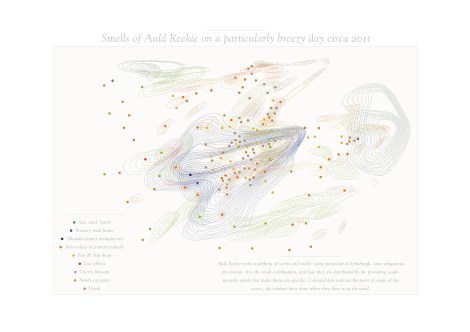Kate McLean, who describes herself as “a sensory researcher, designer, photographer and a lecturer,” makes these very charming sensory maps of cities. “Sensory map” in this case means “a map showing what cities smell like.”
As she told FastCoExist:
“Smells have stories and connect with us at an emotional level, bringing back memories of locations, events, and people,” she says. “Smell maps are designed to provoke a response, to initiate a debate, to encourage people to use their noses, to become more aware of the smells that go to make up our urban environments.”
That sounds like a pleasant enough pursuit, if you’re exploring, for instance, Edinburgh “on a particularly breezy day circa 2011,” as documented in the map above. McLean mapped smells of sea, sand, beach; brewery malt fumes; alkaloid opiates manufactory; fish and chip shops; boys’ toilets in primary schools; cherry blossoms; zoo poo; newly cut grass; and vomit. So basically Edinburgh is a bag of Bertie Bott’s Every Flavor Beans.
Vomit would be a relatively welcome break on the “smelliest block in New York,” which another map documents. There the smells included: stagnant water, sawdust, dried fish, cabbage, car oil, air conditioning, trash, oranges, pee, cheap perfume. Thanks to the map, though, you can go for the oranges and avoid literally everything else.




